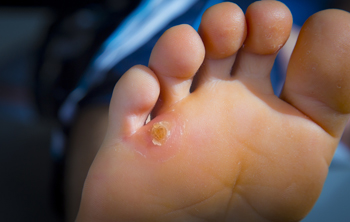Items filtered by date: August 2024
Understanding Seed Corns on the Foot

Seed corns on the foot are small, painful calluses that typically develop on the sole or between the toes. This condition arises from pressure and friction, often caused by wearing ill-fitting shoes or abnormal foot mechanics. Seed corns are characterized by a small, hard central core surrounded by inflamed skin. There are different types of corns, which are hard corns that form on the tops and sides of toes, soft corns, which appear between toes and are softer due to moisture, and seed corns, which are discrete, localized areas. To manage seed corns, it is important to wear comfortable, well-fitting shoes and use protective pads. Regular foot care and avoiding activities that put excessive pressure on the feet can help prevent these painful growths. If you have developed a corn on your foot, it is suggested that you visit a podiatrist who can identify what type of corn it is, and offer appropriate relief options.
If you have any concerns regarding your feet and ankles, contact Robert Dunne, DPM of Lake Washington Foot and Ankle Center. Our doctor will treat your foot and ankle needs.
Corns: What Are They? and How Do You Get Rid of Them?
Corns can be described as areas of the skin that have thickened to the point of becoming painful or irritating. They are often layers and layers of the skin that have become dry and rough, and are normally smaller than calluses.
Ways to Prevent Corns
There are many ways to get rid of painful corns such as wearing:
- Well-fitting socks
- Comfortable shoes that are not tight around your foot
- Shoes that offer support
Treating Corns
Treatment of corns involves removing the dead skin that has built up in the specific area of the foot. Consult with Our doctor to determine the best treatment option for your case of corns.
If you have any questions please feel free to contact our offices located in Melbourne and Palm Bay, FL . We offer the newest diagnostic and treatment technologies for all your foot and ankle needs.
Types of Ankle Sprains

The talus, tibia, and fibula bones reside in the ankle and work together to facilitate movement of the foot in all directions. There are strong ligaments on the inside and outside of the ankle which bind and support these bones as well as the connection between the ankle and lower leg. When these ligaments become overly stretched or even torn during an injury, this is known as an ankle sprain. Ankle sprains are the most common form of ankle injury, and can occur when the ankle rolls outward or inward. Ankle sprains may cause pain ranging from mild to severe, swelling, decreased range of motion, and you may have limited or no ability to walk. Because improperly healed ankle sprains can lead to additional ankle sprains, chronic ankle instability, and even arthritis, it is suggested you schedule an appointment to visit a podiatrist to see if you have sprained your ankle. This type of doctor will be able to properly diagnose your condition and its severity, and treat it effectively.
Ankle sprains are common but need immediate attention. If you need your feet checked, contact Robert Dunne, DPM from Lake Washington Foot and Ankle Center. Our doctor can provide the care you need to keep you pain-free and on your feet.
How Does an Ankle Sprain Occur?
Ankle sprains take place when the ligaments in your ankle are torn or stretched beyond their limits. There are multiple ways that the ankle can become injured, including twisting or rolling over onto your ankle, putting undue stress on it, or causing trauma to the ankle itself.
What Are the Symptoms?
- Mild to moderate bruising
- Limited mobility
- Swelling
- Discoloration of the skin (depending on severity)
Preventing a Sprain
- Wearing appropriate shoes for the occasion
- Stretching before exercises and sports
- Knowing your limits
Treatment of a Sprain
Treatment of a sprain depends on the severity. Many times, people are told to rest and remain off their feet completely, while others are given an air cast. If the sprain is very severe, surgery may be required.
If you have suffered an ankle sprain previously, you may want to consider additional support such as a brace and regular exercises to strengthen the ankle.
If you have any questions please feel free to contact our offices located in Melbourne and Palm Bay, FL . We offer the newest diagnostic and treatment technologies for all your foot and ankle needs.
Common Foot Injuries From Pickleball

As pickleball gains popularity across the nation, foot and ankle injuries are becoming more common among players. The fast-paced, lateral movements and sudden stops required in pickleball often lead to strains, sprains, and fractures. Ankle sprains are frequent due to the rapid direction changes, while plantar fasciitis can develop from the repetitive stress on the feet. Achilles tendonitis is another concern, especially for older players, as the sport's dynamic movements can overburden this tendon at the back of the heel. Despite pickleball being a low-impact sport, the risk of injury to players remains significant. Regularly stretching and warming up before playing can help to avoid injuries, but seeing a podiatrist is essential for those experiencing foot pain. A podiatrist can diagnose and treat foot and ankle injuries, recommend proper footwear, and provide strategies to prevent future problems. If you have foot or ankle pain connected to playing pickleball, it is suggested that you schedule an appointment with a podiatrist.
Ankle and foot injuries are common among athletes and in many sports. They can be caused by several problems and may be potentially serious. If you are feeling pain or think you were injured in a sporting event or when exercising, consult with Robert Dunne, DPM from Lake Washington Foot and Ankle Center. Our doctor will assess your condition and provide you with quality foot and ankle treatment.
Common Injuries
The most common injuries that occur in sporting activities include:
- Achilles Tendonitis
- Achilles Tendon Rupture
- Ankle Sprains
- Broken Foot
- Plantar Fasciitis
- Stress Fractures
- Turf Toe
Symptoms
Symptoms vary depending upon the injury and in some cases, there may be no symptoms at all. However, in most cases, some form of symptom is experienced. Pain, aching, burning, bruising, tenderness, tightness or stiffness, sensation loss, difficulty moving, and swelling are the most common symptoms.
Treatment
Just as symptoms vary depending upon the injury, so do treatment options. A common treatment method is known as the RICE method. This method involves rest, applying ice, compression and elevating the afflicted foot or ankle. If the injury appears to be more serious, surgery might be required, such as arthroscopic or reconstructive surgery. Lastly, rehabilitation or therapy might be needed to gain full functionality in the afflicted area. Any discomfort experienced by an athlete must be evaluated by a licensed, reputable medical professional.
If you have any questions, please feel free to contact our offices located in Melbourne and Palm Bay, FL . We offer the newest diagnostic and treatment technologies for all your foot care needs.
Heel Pain in the Morning?
Foot Pain Relief From Prolonged Standing
 Working on your feet all day can lead to significant foot pain, but there are several strategies to alleviate discomfort. Start by wearing supportive, well-fitted shoes with good arch support and cushioning to reduce strain on your feet. Custom orthotic inserts can provide additional support tailored to your foot's unique shape. Take regular breaks to sit down and rest your feet, even if it is just for a few minutes. Stretching exercises, such as calf stretches and toe flexes, can improve flexibility and reduce muscle tension. Incorporate foot massages and rolling your feet over a tennis ball to relieve pressure points and enhance circulation. Maintaining a healthy weight can reduce the stress on your feet. At the end of the day, elevate your feet to decrease swelling. If foot pain persists, it is suggested that you consult a podiatrist for a thorough evaluation and personalized treatment plan for more tips and to address any underlying issues.
Working on your feet all day can lead to significant foot pain, but there are several strategies to alleviate discomfort. Start by wearing supportive, well-fitted shoes with good arch support and cushioning to reduce strain on your feet. Custom orthotic inserts can provide additional support tailored to your foot's unique shape. Take regular breaks to sit down and rest your feet, even if it is just for a few minutes. Stretching exercises, such as calf stretches and toe flexes, can improve flexibility and reduce muscle tension. Incorporate foot massages and rolling your feet over a tennis ball to relieve pressure points and enhance circulation. Maintaining a healthy weight can reduce the stress on your feet. At the end of the day, elevate your feet to decrease swelling. If foot pain persists, it is suggested that you consult a podiatrist for a thorough evaluation and personalized treatment plan for more tips and to address any underlying issues.
While working on the feet, it is important to take the proper care of them. For more information about working on your feet, contact Robert Dunne, DPM from Lake Washington Foot and Ankle Center. Our doctor will treat your foot and ankle needs.
Working on Your Feet
Standing on your feet for long periods of time can cause stress and pain in your feet. Your whole body may experience change in terms of posture, back pain, bunions, callouses and or plantar warts. There are ways to avoid these conditions with proper foot care, smart choices and correct posture.
Positive Changes
Negative heeled shoe – Choosing this shoe type places the heel slightly lower than the ball of the foot. These are great for overall foot health. Find shoes that fit you correctly.
Go barefoot – Our feet were not designed to be enclosed for all hours of the day. Try to periodically expose your feet to air.
Eliminate Pain
Foot Exercises – Performing simple exercises, incorporating yoga and doing stretches are beneficial. This will allow increased blood flow to the area and muscles of the foot.
Achilles tendon – Stretching the foot out flat on the floor will relax the calf muscles and tendon. These exercises can be performed almost anywhere. Make sure you add these exercises to your daily regimen.
With a little bit of this information and knowing more about foot health, you will notice changes. Foot stretches and proper footwear will help with pain and prevent further issues.
If you have any questions please feel free to contact our offices located in Melbourne and Palm Bay, FL . We offer the newest diagnostic and treatment technologies for all your foot and ankle needs.

